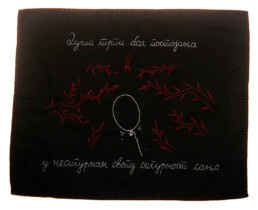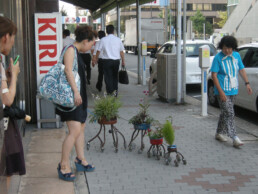Škart
Like a comet, the manager falls down to land, felled by a worker’s mighty hand
text, drawing and embroidery: Lenka Zelenović
40 cm x 35 cm
2006
From your terrace, rubbish do not dump, or everyone will see you’re a slovenly frump
text, drawing and embroidery: Lenka Zelenović
47 cm x 30 cm
2007
Everyone wants to go very fast, till the end of our lives we’ll surely last
text and embroidery: Brigita Međo
drawing: Vladan Nikolić
68 cm x 45 cm
2012
The pain of existence makes the soul burst at the seams, in an uncertain world, of safety it dreams
text and embroidery: Brigita Međo
drawing: Vladan Nikolić
68 cm x 55 cm
2012
Dish-Familysh, Bush-o-Rush
Plant-o-biles Serie
ambiental mobile installation
variable dimensions
2010
New embroideries
series of embroidery on canvas
Like a comet, the manager falls down to land, felled by a worker’s mighty hand
text, drawing and embroidery: Lenka Zelenović
40 cm x 35 cm
2006
From your terrace, rubbish do not dump, or everyone will see you’re a slovenly frump
text, drawing and embroidery: Lenka Zelenović
47 cm x 30 cm
2007
Everyone wants to go very fast, till the end of our lives we’ll surely last
text and embroidery: Brigita Međo
drawing: Vladan Nikolić
68 cm x 45 cm
2012
The pain of existence makes the soul burst at the seams, in an uncertain world, of safety it dreams
text and embroidery: Brigita Međo
drawing: Vladan Nikolić
68 cm x 55 cm
2012
The works from the New Embroideries Series were exhibited at the 48th October Salon, Micro-Narratives. The Škart Group won the 48th October Salon Award for this work.
In the summer of 2000, we took courage to encourage several women’s groups to, after a century and a half of transcribed embroideries, put their own views and doubts on canvas. Since then, embroideries have emerged that no longer deal only with the idyllic image of an obedient, God-fearing, naive housewife, but also with the readiness to face family, social and political prejudices.
Small is big. Kitchen whispers are remembered longer than school dictations. New embroideries are here to replace the wrong ideas.
Škart, from the catalogue of the 48th October Salon
The initiative with New Embroideries gave new life to the traditional embroideries, which, besides the walls in households, find their place in art galleries, and give various authors who create them the opportunity to become equal actors on the contemporary art scene. Lenka Zelenović, one of the most prominent members of the Škart Group, has so far made hundreds of them, with different motives and messages, referring to the critique of the local political situation, ecological and emotional messages.
© Cultural Centre of Belgrade, the October Salon Collection and the artists
Gift Contract: III-5-291/1/25.9.2014.
Inventory No. 1354, 1355, 1356, 1357Photo: Courtesy of the artist, Milan Kralj
Selected Bibliography:
48th October Salon, Micro-Narratives. Cultural Centre of Belgrade, 2007
Nove kuvarice umjetničke grupe Škart, Vox Femine, Oct. 29, 2012, https://voxfeminae.net/vijesti/nove-kuvarice-umjetnicke-grupe-skart/ (accessed on Apr. 26, 2020)
Iva Parađanin, “Feministički i borbeni vezovi žena Srbije”, VICE, May 18, 2017, https://www.vice.com/rs/article/gvzkey/feministicki-i-borbeni-vezovi-zena-srbije (accessed on Apr. 26, 2020)
Dish-Familysh, Bush-o-Rush
Plant-o-biles Serie
ambiental mobile installation
variable dimensions
2010
Plant-o-biles is part of a larger installation, i.e., the exhibition titled Seesaw Play-Grow (a polygon of imbalance), which the Škart Group made for the Serbian Pavilion at the 12th Biennial of Architecture in Venice in 2010.
It consists of two families: the sneaking family and the rolling plant.
Seesaw Play-Grow is a metaphor of space, which with its dynamics and contrast should provoke the viewer to find answers to questions about the essence of the work. Like Seesaw Play-Grow, Plant-o-biles also re-examines the relationship between the urban environment and nature. Plant-o-biles, as a kind of counter-object, calls for play and dialogue.
It reflects on the relationship between the urban environment and nature and is inspired by Vasko Popa’s Metropolis Poem: My wife, who I would do anything for, told me once, I would like to have a small green tree that would run after me down the street!
© Cultural Centre of Belgrade, the October Salon Collection and the artists
Purchase Contract: III-5-497/1/22.12.2014, III-5-498/1/22.12.2014.
Inventory No. 1387, 1388
Photo: Courtesy the artists
Selected Bibliography:
Škart: Poluvreme, Oct. 9–26, 2012, catalogue of the retrospective exhibition, Museum of Applied Arts, Belgrade, 2012
ABOUT THE AUTHORS:
Škart is a collective founded in 1990 at the Faculty of Architecture in Belgrade. The group consists of architects-designers Đorđe Balmazović Žole (1965, Belgrade, Serbia) and Dragan Protić Prota (1965, Zrenjanin, Serbia) with the occasional participation of various artists, colleagues, acquaintances, craftsmen or amateur poets. Their art is created on the borders of activism, poetry, music, architecture, fine and applied arts. A wide field of activity enables the members of the group the “social production of space”, i.e., a unique impact on the society in which they act, within the art system or completely outside it. The group’s activities in urban environments, as well as in outlying areas, show courage and inventiveness, with a certain dose of lucidity and activist humour, which are the elements of this collective’s aspiration to deal with some issues of modern society in a witty and analytical way. The first decade (1990 – 2000) was marked by “samizdat” books and their distribution in the street actions. In the second decade (2000 – 2010), the group co-founded several new collectives: the choirs Horkeškart and Proba, children’s choirs Deca sa meseca and AprilZMAJun, the youth-retired person’s choir HOR-RUK and the antifascist choir UHO (united choirs). Since 2010 the collective has been increasingly involved in working with children (at the “Vera Radivojević” Children’s Home in Bela Crkva) and with retired people. They have exhibited as a group and individually at numerous exhibitions in the country and abroad. In 2010 they represented Serbia at the Venice Biennale of Architecture. Мore information at www.skart.rs


